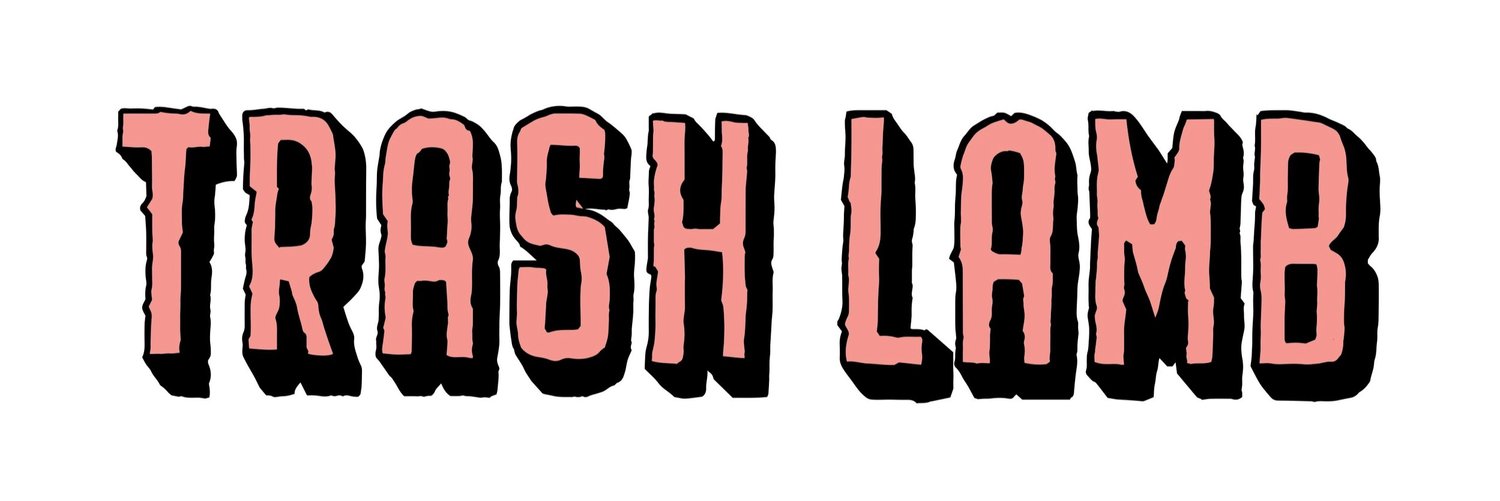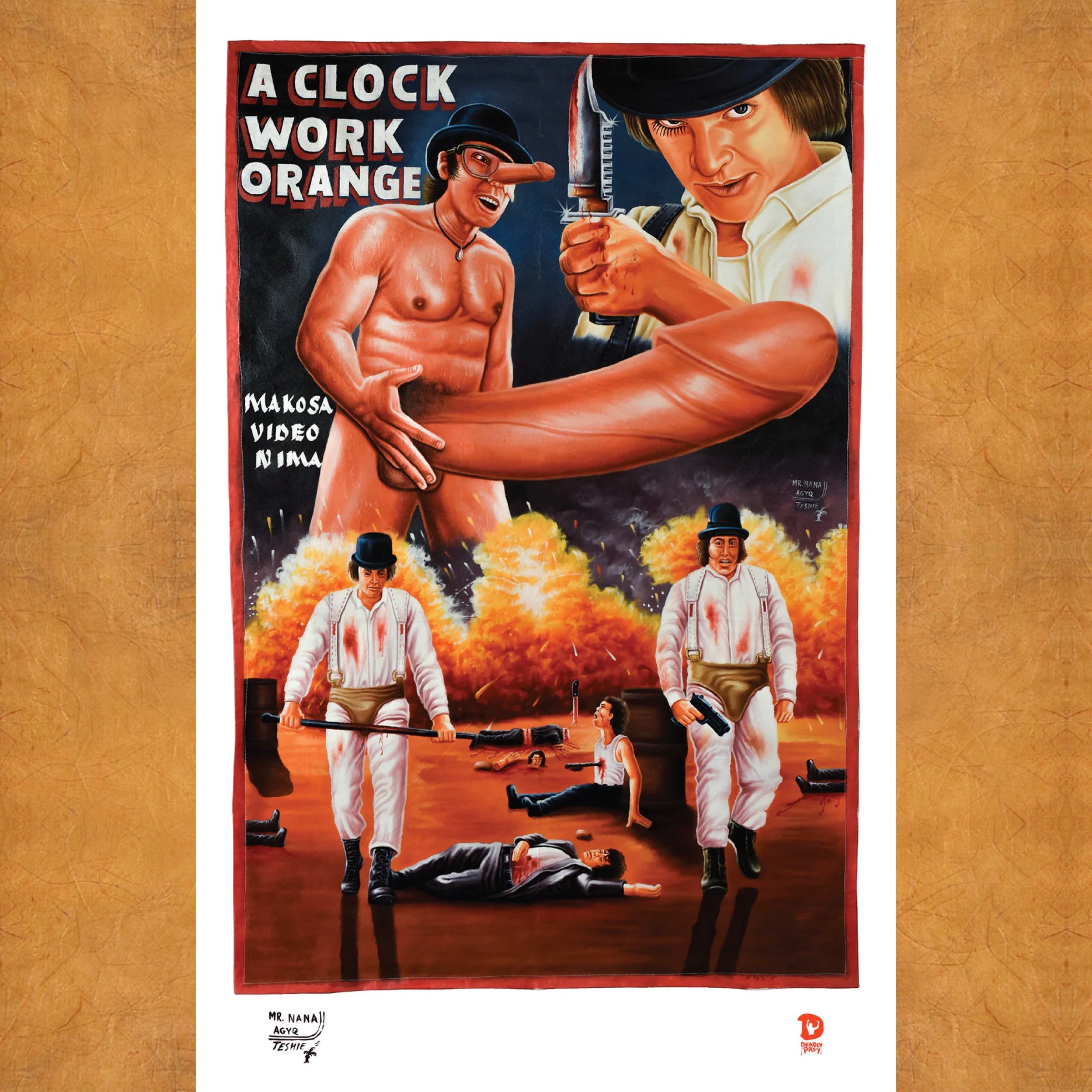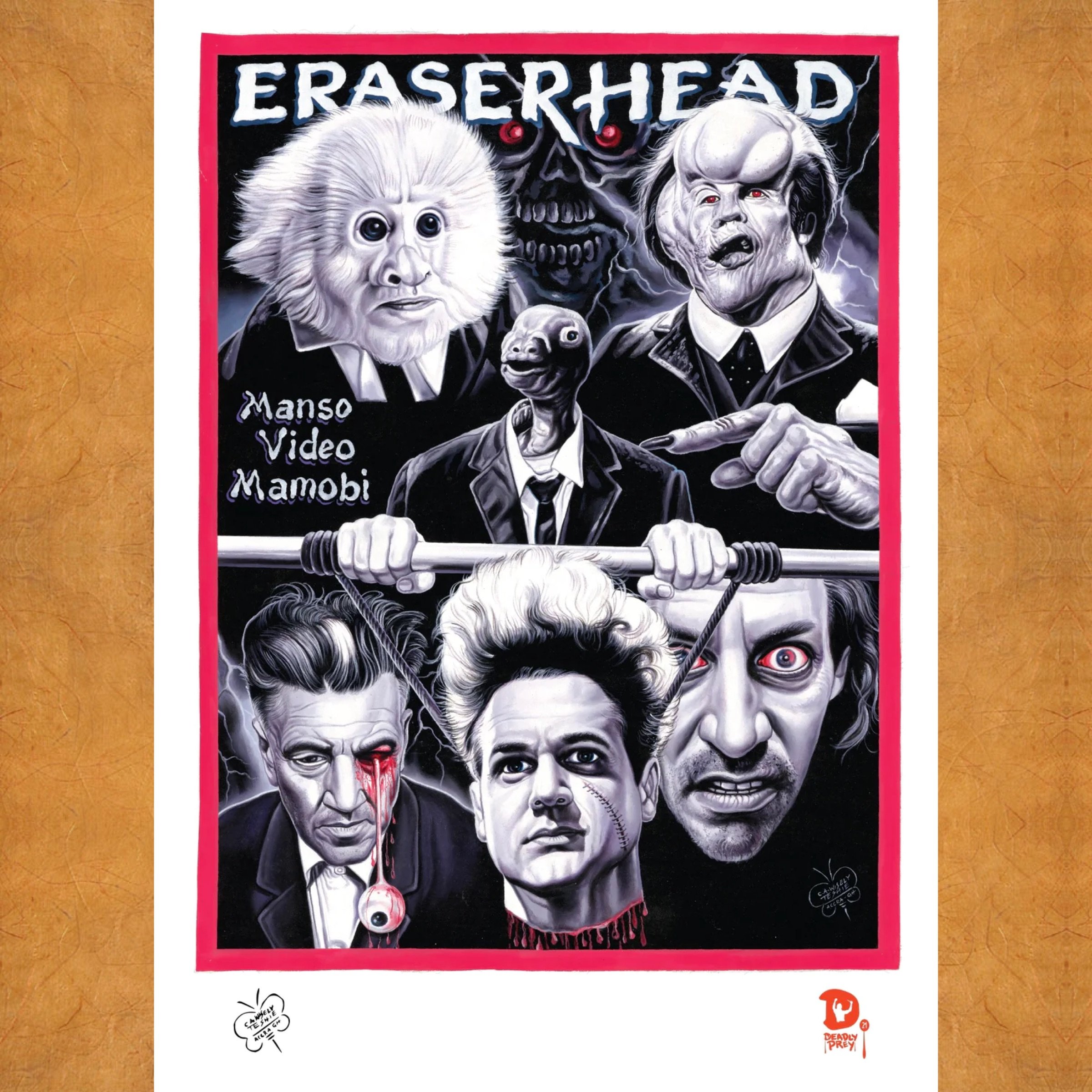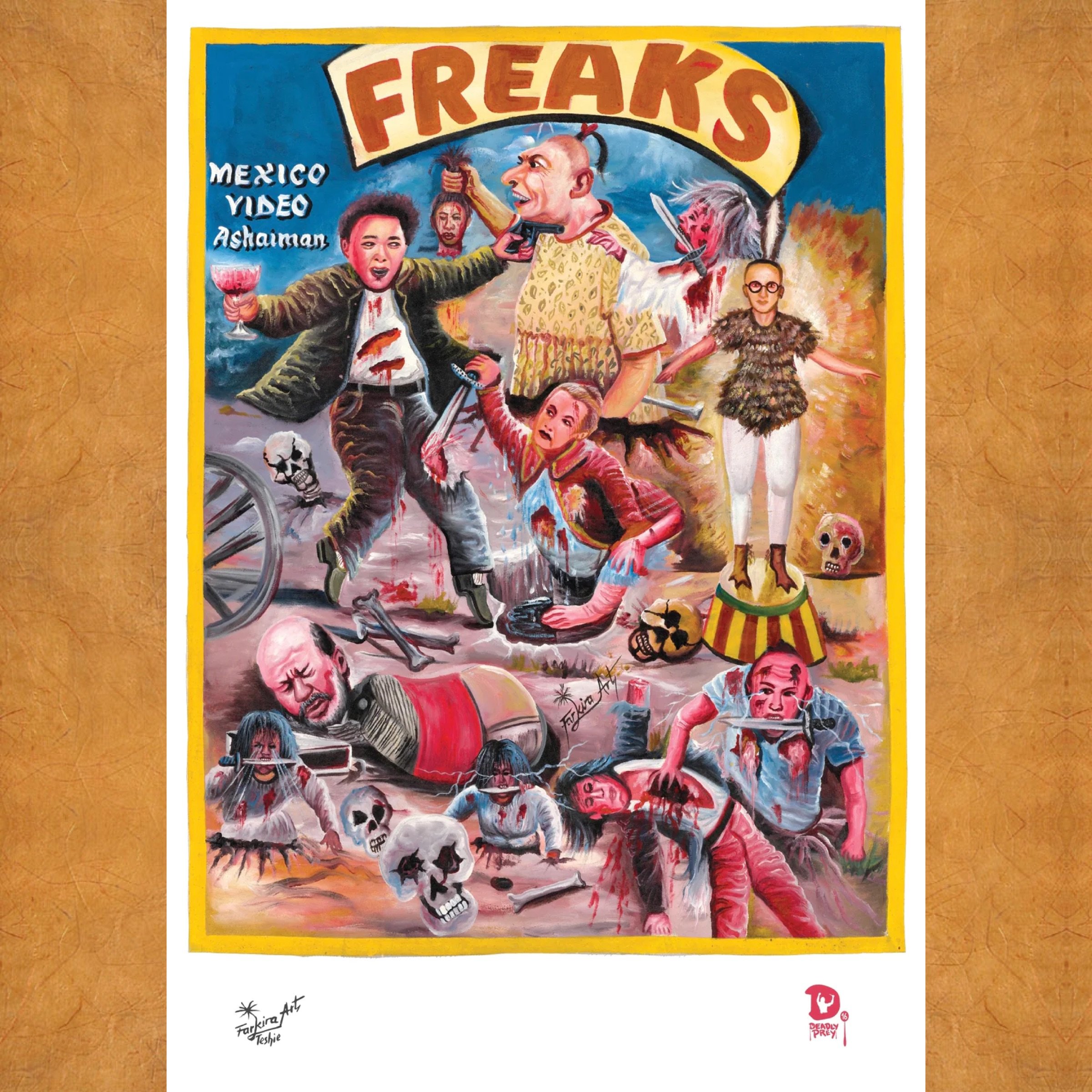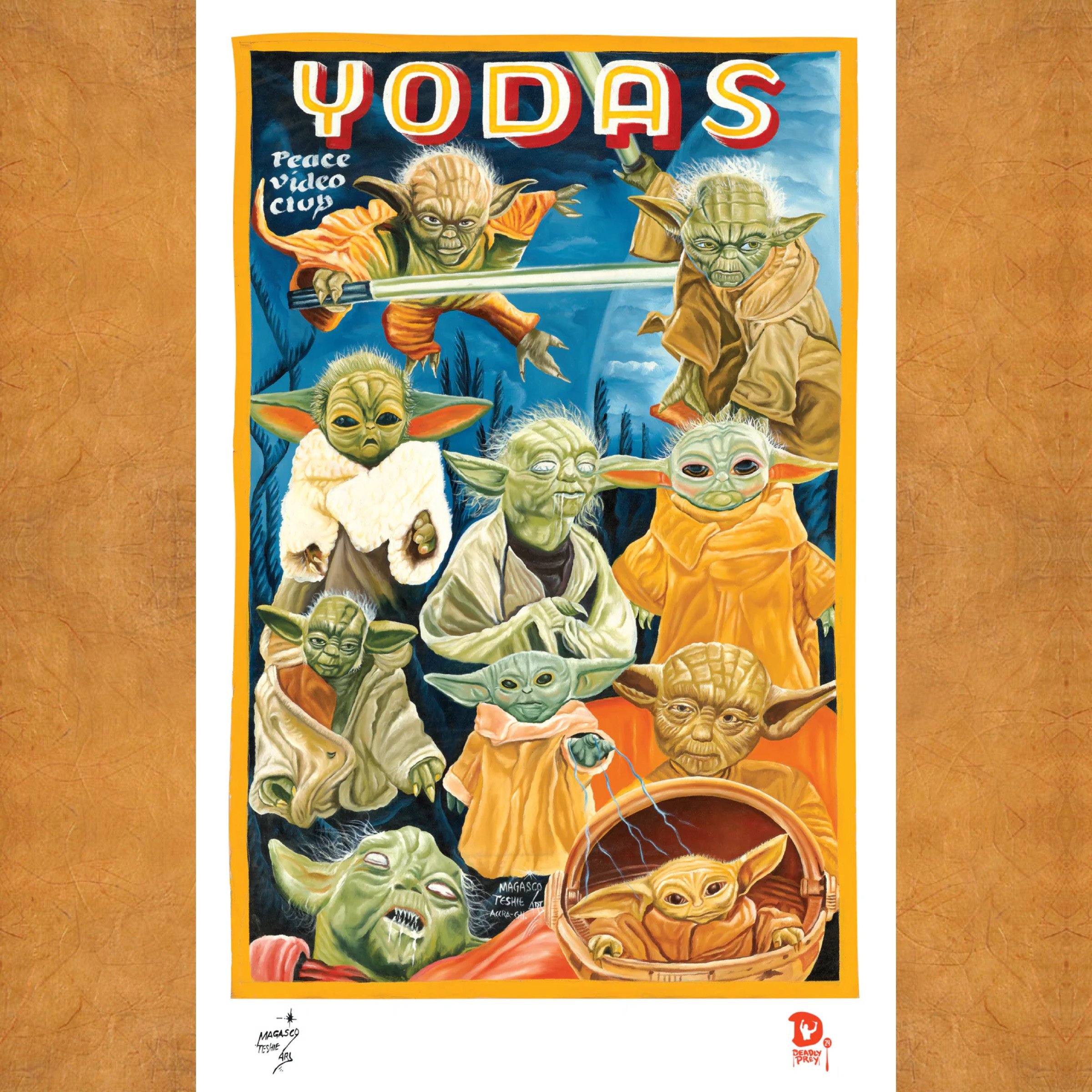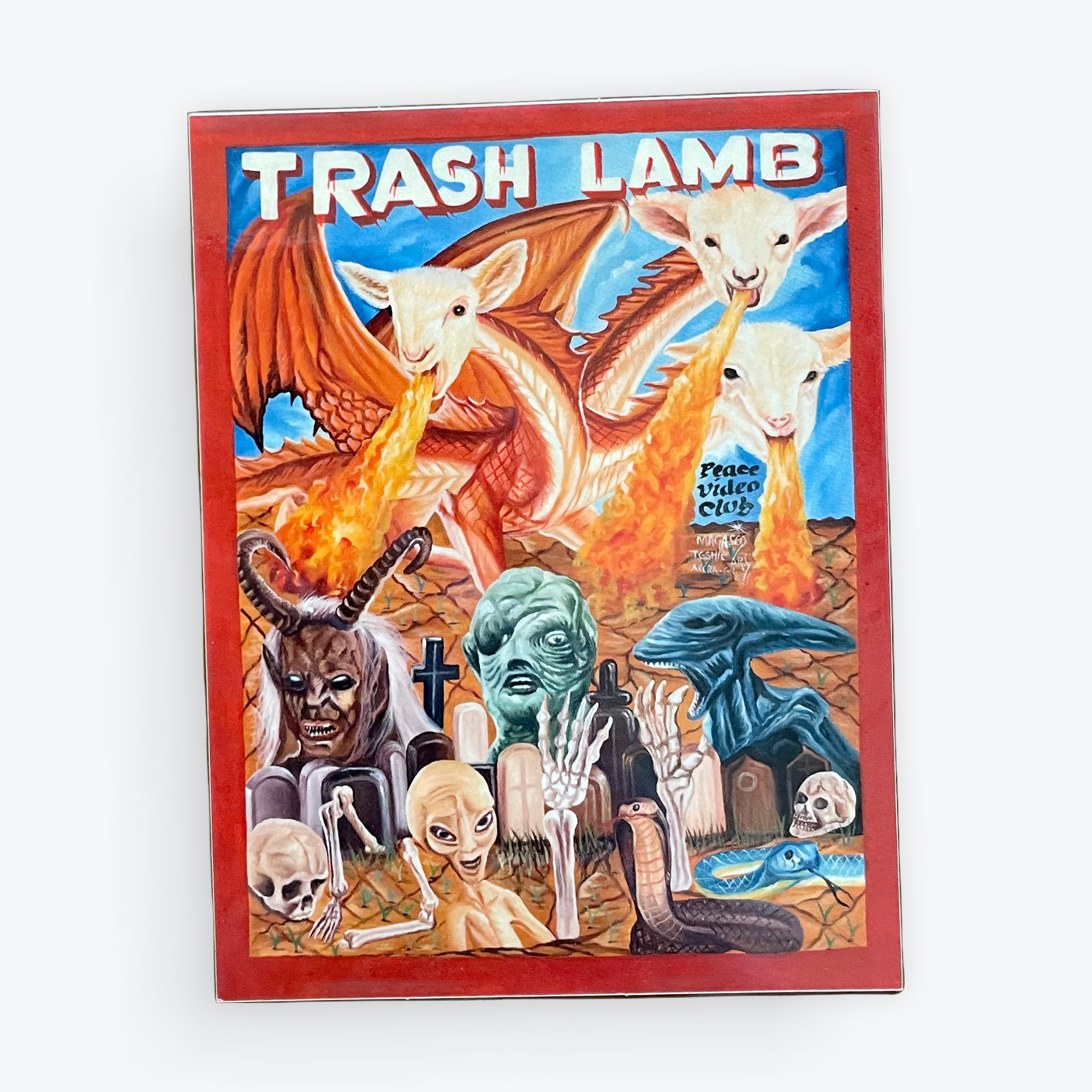DEADLY PREY GALLERY
SHOWCASE
April 5 to September 22, 2024
Deadly Prey Gallery is a Chicago-based traveling art gallery working with 10 artists in and around Accra, Ghana.
Deadly Prey is dedicated to the preservation of hand-painted Ghanian movie posters, with the central focus being supporting the incredible artists currently painting them.
This exhibition features a selection of both original paintings and affordably-priced prints from each of the various artists that they work with in Ghana.
Meet some of the artists…
-

Heavy J with his Kill Bill painting
Heavy J has been painting movie posters in Ghana since the mid 90’s. He’s been making commission paintings with Deadly Prey Gallery (then Odd Obsession Movies) since 2012.
-
Farkira working on his Fantastic Planet painting
Farkira has been painting movie posters in Ghana since the early 90’s. He’s been making commission paintings with Deadly Prey Gallery (then Odd Obsession Movies) since 2014.
-

C.A. Wisely with his Evil Dead painting
C.A. has been painting movie posters in Ghana since the mid 2000’s after apprenticing under Heavy J. He’s been making commission paintings with Deadly Prey Gallery since 2018
-
Mr. Nana Agyq with his Stop Making Sense painting
Mr. Nana Agyq started painting movie posters in the late 1990’s. He’s been making commission paintings with Deadly Prey Gallery since 2012.
-
Salvation working on his Gleaming the Cube painting
Salvation started painting movie posters in the late 1990’s. He’s been making commission paintings with Deadly Prey Gallery since 2012.
-

Magasco with his Trash Lamb painting
Magasco has been painting movie posters in Ghana since the early 2000’s after apprenticing under Farkira. He’s been making commission paintings with Deadly Prey Gallery since 2018. This painting wa commissioned by Trash LambGallery in 2023, in honor of the 3-year anniversary.
Ghanian Mobile Cinemas
Mobile cinemas in Ghana were essentially traveling movie shows. Operators, often equipped with a generator, a VCR (Video Cassette Recorder), a television or later, projectors, and speakers, would move from town to town, or within neighborhoods in larger cities, setting up temporary outdoor cinemas. This was a period when access to television and VCRs was limited in many parts of Ghana, and these mobile cinemas provided a way for people to experience films, particularly in areas without fixed cinema theaters. These mobile cinemas and their hand-painted movie posters are a fascinating part of Ghana's cultural history, particularly prominent in the 1980s and 1990s. This phenomenon arose in a unique socio-economic and technological context, blending the need for accessible entertainment with the vibrant artistic tradition of the region.
The selection of films varied widely, encompassing Hollywood blockbusters, Bollywood hits, Hong Kong martial arts movies, and locally produced films. These screenings not only offered entertainment but also became social events, bringing communities together.
Hand-Painted Movie Posters
The hand-painted movie posters associated with these mobile cinemas are a unique art form that emerged from this movement. Since most of the films shown were on VHS tapes without any promotional materials, and considering the need to attract audiences in a visually compelling way, cinema operators commissioned local artists to create large, vibrant posters for each film they screened.
These artists, often self-taught and working with limited resources, used their creativity to depict scenes from the movies, sometimes without having seen the films themselves. This led to imaginative, exaggerated, and sometimes surreal interpretations of the movies' content. The artwork was characterized by bold colors, dramatic portrayals of the main characters, and attention-grabbing titles, all designed to captivate and draw in potential viewers.
Cultural and Artistic Significance
The hand-painted movie posters of Ghana have gained international attention for their artistic value and unique cultural expression. They represent a blend of traditional Ghanaian artistic styles with the influence of global cinema. The creativity and skill of these artists have been celebrated in art exhibitions around the world, turning what was once a practical advertising tool into a collectible form of contemporary art.
Decline and Legacy
With advances in technology, the proliferation of digital printing, and the wider availability of television and internet services, the demand for mobile cinemas and their hand-painted posters has declined. However, the posters that remain have become highly prized by collectors and are recognized as an important part of Ghana's cultural heritage and the global history of cinema.
The legacy of this movement continues to inspire contemporary artists and filmmakers in Ghana and beyond, reminding us of a time when cinema was a traveling spectacle, and art played a crucial role in bringing stories to life
Alien / 2020 / Magasco / Oil and local house paint mixture on two sewn together recycled flour sacks / 38 x 59 inches / $700
Battle Royal 2 / 2020 / J.A. Pastony / Oil and local house paint on a single recycled flour sack (used condition) / 33 x 42 inches / $475 🔴
Black Panther / 2021 / Stoger / Oil and local house paint mixture on two sewn together recycled flour sacks / 40 x 61 inches / $700
Blade / 2022 / Heavy J / Oil and local house paint mixture on two sewn together recycled flour sacks / 40 x 62 inches / $950
Con Air / Late 2010’s / Heavy J / Oil and local house paint mixture on two sewn together recycled flour sacks / 40 x 61 inches / $800 🔴
Dazed and Confused / 2023 / Leonardo / Oil and local house paint mixture on two sewn together recycled flour sacks / 41 x 61 inches / $800
Everything, Everywhere, All at Once / 2023 / Farkira / Oil and local house paint mixture on two sewn together recycled flour sacks / 41 x 62 inches / $675 🔴
Fright Night / 2022 / Heavy J / Oil and local house paint mixture on two sewn together recycled flour sacks / 40 x 62 inches / $950
From Beyond / 2020 / A. Michael Art / Oil and local house paint on a single recycled flour sack / 34 x 42 inches / $325
Halloween / 2020 / Eric Sojay / Oil and local house paint on a single recycled flour sack / 31 x 40 inches / $300
Hellraiser / 2020 / D.A. Armahsco / Oil and local house paint on a single recycled flour sack / 37 x 42 inches / $325
King Kong / 2022 / Death is Wonder / Oil and local house paint mixture on two sewn together recycled flour sacks / 30 x 56 inches / $600 🔴
Magnolia / 2022 / Mr. Nana Agyq / Oil and local house paint mixture on two sewn together recycled flour sacks / 39 x 59 inches / $700
Mars Attacks / 2023 / Papa Warsti / Oil and local house paint on a single recycled flour sack / 34 x 41 inches / $400 🔴
Paranoid / 2020 / Papa Warsti / Oil and local house paint on a single recycled flour sack / 32 x 40 inches / $350 🔴
Predator / 2021 / Salvation / Oil and local house paint mixture on two sewn together recycled flour sacks / 40 x 62 inches / $900
The Expendables / Rambo / 2022 / Death is Wonder / Oil and local house paint mixture on two sewn together recycled flour sacks / 31 x 61 inches / $600
Re-incarnation / 2021 / H.K. Mathias / Oil and local house paint mixture on two sewn together recycled flour sacks / 40 x 57 inches / $575
Repo Man / 2023 / Farkira / Oil and local house paint mixture on two sewn together recycled flour sacks / 40 x 61 inches / $750
Reservoir Dogs / 2024 / Mr. Nana Agyq / Oil and local house paint mixture on two sewn together recycled flour sacks / 39 x 59 inches / $1200
Rocky / 2021 / C.A. Wisely / Oil and local house paint mixture on two sewn together recycled flour sacks / 40 x 70 inches / $675
Serial Killers / early 2010’s / Leonardo / Oil and local house paint mixture on two sewn together recycled flour sacks (used condition) / 47 x 62 inches / $600
Speed / 2023 / Bright Obeng / Oil and local house paint mixture on two sewn together recycled flour sacks / 38 x 55 inches / $950
Tatoo / 2020 / A. Michael / Oil and local house paint on a single recycled flour sack (used condition) / 34 x 42 inches / $400 🔴
Terminator 2 / 2020 / Magasco / Oil and local house paint mixture on two sewn together recycled flour sacks / 38 x 60 inches / $600
The Boxer’s Omen / 2022 / Leonardo / Oil and local house paint mixture on two sewn together recycled flour sacks / 40 x 60 inches / $600
The Thing / 2021 / Papa Warsti / Oil and local house paint on a single recycled flour sack (used condition) / 32 x 45 inches / $475 🔴
The Witch / 2021 / Stoger / Oil and local housepaint on a single recycled flour sack / 30 x 40 inches / $700
They Live / 2023 / Nii Bi Ashitey / Oil and local house paint mixture on two sewn together recycled flour sacks / 38 x 58 inches / $750
Tremors / 2023 / Farkira / Oil and local house paint mixture on two sewn together recycled flour sacks / 41 x 61 inches / $750
Dazed and Confused / Leonardo / Archival Giclée Print on Cotton Rag Paper (290 GSM), Limited Edition of 25, hand numbered and embossed with the Deadly Prey Logo / 24 x 34 inches / $150
2001: A SPACE ODYSSEY / Farkira / High quality, digital print on FSC certified 100 lb card stock with 100% bio-degradable ink / 14 x 22 inches / $25
7th Voyage of Singbad / Mr. Brew / High quality, digital print on FSC certified 100 lb card stock with 100% bio-degradable ink / 14 x 19 inches / $25
A Clockwork Orange / Mr. Nana Agyq / High quality, digital print on FSC certified 100 lb card stock with 100% bio-degradable ink / 14 x 22 inches / $25
African Battle Royal / Heavy J / High quality, digital print on FSC certified 100 lb card stock with 100% bio-degradable ink / 14 x 19 inches / $25
Anchorman / Salvation / High quality, digital print on FSC certified 100 lb card stock with 100% bio-degradable ink / 14 x 22 inches / $25
Antiques Roadhouse / Heavy J / High quality, digital print on FSC certified 100 lb card stock with 100% bio-degradable ink / 14 x 22 inches / $25
Battle Royal / Heavy J / High quality, digital print on FSC certified 100 lb card stock with 100% bio-degradable ink / 14 x 19 inches / $25
Black Swan /Heavy J / High quality, digital print on FSC certified 100 lb card stock with 100% bio-degradable ink / 14 x 22 inches / $25
Blue Velvet / Farkira / High quality, digital print on FSC certified 100 lb card stock with 100% bio-degradable ink / 14 x 22 inches / $25
Blue Velvet / Heavy J / High quality, digital print on FSC certified 100 lb card stock with 100% bio-degradable ink / 14 x 22 inches / $25
Cheers / Stoger / High quality, digital print on FSC certified 100 lb card stock with 100% bio-degradable ink / 14 x 22 inches / $25
Curb Your Enthusiasm / Heavy J / High quality, digital print on FSC certified 100 lb card stock with 100% bio-degradable ink / 14 x 22 inches / $25
Dune / Farkira / High quality, digital print on FSC certified 100 lb card stock with 100% bio-degradable ink / 14 x 22 inches / $25
El Topo / Leonardo / High quality, digital print on FSC certified 100 lb card stock with 100% bio-degradable ink / 14 x 22 inches / $25
Eraserhead / C.A. Wisely / High quality, digital print on FSC certified 100 lb card stock with 100% bio-degradable ink / 14 x 20 inches / $25
Everything Everywhere All At Once / Salvation / High quality, digital print on FSC certified 100 lb card stock with 100% bio-degradable ink / 14 x 20 inches / $25
Freaks / Farkira / High quality, digital print on FSC certified 100 lb card stock with 100% bio-degradable ink / 14 x 20.5 inches / $25
Garfield / Heavy J / High quality, digital print on FSC certified 100 lb card stock with 100% bio-degradable ink / 14 x 22 inches / $25
Ghost World / C.A. Wisely / High quality, digital print on FSC certified 100 lb card stock with 100% bio-degradable ink / 14 x 22 inches / $25
Grey Gardens / Stoger / High quality, digital print on FSC certified 100 lb card stock with 100% bio-degradable ink / 14 x 22 inches / $25
Groundhog Day / C.A. Wisely / High quality, digital print on FSC certified 100 lb card stock with 100% bio-degradable ink / 14 x 22 inches / $25
Harold and Maude / Heavy J / High quality, digital print on FSC certified 100 lb card stock with 100% bio-degradable ink / 14 x 20 inches / $25
Gummo / Salvation / High quality, digital print on FSC certified 100 lb card stock with 100% bio-degradable ink / 14 x 22 inches / $25
Pee Wee's Big Adventure / Heavy J / High quality, digital print on FSC certified 100 lb card stock with 100% bio-degradable ink / 14 x 22 inches / $25
Pee Wee's Big Adventure / Stoger / High quality, digital print on FSC certified 100 lb card stock with 100% bio-degradable ink / 14 x 22 inches / $25
Pink Flamingos / Heavy J / High quality, digital print on FSC certified 100 lb card stock with 100% bio-degradable ink / 14 x 22 inches / $25
Purple Rain / Heavy J / High quality, digital print on FSC certified 100 lb card stock with 100% bio-degradable ink / 14 x 22 inches / $25
Rushmore / Salvation / High quality, digital print on FSC certified 100 lb card stock with 100% bio-degradable ink / 14 x 22 inches / $25
Yodas / Magasco / High quality, digital print on FSC certified 100 lb card stock with 100% bio-degradable ink / 14 x 22 inches / $25
Wayne's World / Mr. Nana Agyq / High quality, digital print on FSC certified 100 lb card stock with 100% bio-degradable ink / 14 x 22 inches / $25
Masks / Heavy J / High quality, digital print on FSC certified 100 lb card stock with 100% bio-degradable ink / 14 x 22 inches / $25
Trash Hampers / Farkira / High quality, digital print on FSC certified 100 lb card stock with 100% bio-degradable ink / 14 x 22 inches / $25
Twin Peaks - Leonardo / High quality, digital print on FSC certified 100 lb card stock with 100% bio-degradable ink / 14 x 22 inches / $25
Twin Peaks / Salvation / High quality, digital print on FSC certified 100 lb card stock with 100% bio-degradable ink / 14 x 22 inches / $25
Trash Lamb Sticker - Magasco / Artwork commissioned by Trash Lamb Gallery in 2023 in honor of our 3-year anniversary / High quality, fade resistant & waterproof vinyl / 3.5 x 4.5 inches / $5.75
Trash Lamb Postcard - Magasco / Artwork commissioned by Trash Lamb Gallery in 2023 in honor of our 3-year anniversary / 4.25 x 5.5 inches / Printed on premium cardstock / $1.75
Trash Lamb T-Shirt - Magasco / Artwork commissioned by Trash Lamb Gallery in 2023 in honor of our 3-year anniversary / $35-$40

Limited Edition Book - Featuring work by the artists Heavy J, Salvation, Stoger, Mr. Nana Agyq, Farkira, and Leonardo / Offset edition of 3,000 / Printed May 2020, Perfectly Acceptable Press, Chicago / $35
